Mount Washington Cog Railway
The Mount Washington Cog Railway, also known as the Cog, is the world's first mountain-climbing cog railway (rack-and-pinion railway). The railway is still in operation, climbing Mount Washington in New Hampshire, United States. It uses a Marsh rack system and both steam and biodiesel-powered locomotives to carry tourists to the top of the mountain. Its track is built to a 4 ft 8 in (1,422 mm) gauge, which is technically a narrow gauge, as it is 1⁄2 inch (1.3 cm) less than a 4 ft 8 1⁄2 in (1,435 mm) standard gauge.
| Mount Washington Cog Railway | |
|---|---|
 Track with rack | |
| Overview | |
| Locale | Coos County, New Hampshire, U.S. |
| Operation | |
| Opened | 1868–present |
| Technical | |
| Line length | 3 miles (4.8 km)[1] |
| Track gauge | 4 ft 8 in (1,422 mm) |
| Rack system | Marsh rack system |
It is the second steepest rack railway in the world after the Pilatus Railway in Switzerland,[2] with an average grade of over 25% and a maximum grade of 37%. The railway is approximately 3 miles (5 km) long and ascends Mount Washington's western slope, beginning at an elevation of approximately 2,700 feet (820 m) above sea level and ending just short of the mountain's summit peak of 6,288 feet (1,917 m). The train ascends the mountain at 2.8 miles per hour (4.5 km/h) and descends at 4.6 mph (7.4 km/h). Steam locomotives take approximately 65 minutes to ascend and 40 minutes to descend, while the biodiesel engines can go up in as little as 36 minutes.
Most of the Mount Washington Cog Railway is in Thompson and Meserve's Purchase, with the part of the railway nearest to Mount Washington's summit being in Sargent's Purchase.
History
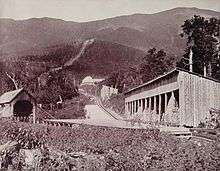
The railway was built by Sylvester Marsh[3] who grew up in Campton. Marsh came up with the idea while climbing the mountain in 1852.[4] His plan was treated as insane. Local tradition says that the state legislature voted permission based on a consensus that harm resulting from operating it was no issue – since the design was attempting the impossible – but benefits were guaranteed. He was putting up $5,000 of his own money, and that, plus whatever else he could raise, would be spent locally, including building the Fabyan House hotel at nearby Fabyan Station to accommodate the expected tourists. The railway is sometimes called "Railway to the Moon", because one state legislator remarked during the proceedings that Marsh should be given a charter, not merely up Mount Washington, but also to the Moon.
Marsh obtained a charter for the road on June 25, 1858, but the American Civil War prevented any action until May 1866.[4] He developed a prototype locomotive and a short demonstration section of track, then found investors and started construction. The route closely followed a mountain trail that had been established earlier in the century by Ethan Allen Crawford.[5]
Despite the railroad's incomplete state, the first paying customers started riding on August 14, 1868, and the construction reached the summit in July 1869.[4] The early locomotives - represented today by the restored display locomotive, #1 Old Peppersass[6] – all had vertical boilers, like many stationary steam engines of the time; the boilers were mounted to the locomotives' frames with twin trunnions, allowing them to pivot as the locomotive and coach climbed the grade, permitting gravity to always keep the boiler vertically oriented, no matter what the gradient of the track. Later designs introduced horizontal boilers, slanted so that they remain close to horizontal on the steeply graded track.
In August 1869, President Ulysses S. Grant visited New England to escape the heat of summer in Washington, D.C. During his tour he rode the cog railway to the top of Mount Washington.[7]
Running the railway
Sylvester Marsh died in 1884 and control of the Cog passed to the Concord & Montreal Railroad, which ran it until 1889 when the Boston & Maine Railroad took over.[8][9] From 1868 to 1910, the locomotives were fired with wood. In 1910, the railway converted to using coal for all its locomotives.[10]
Control by the Teagues began in 1931 when Col. Henry N. Teague bought the Cog. He died in 1951, and Arthur S. Teague became general manager, then gained ownership in 1961. (Arthur Teague was the colonel's protégé, but no relation.) After he died in 1967, the ownership passed to his wife, Ellen Crawford Teague, who ran the Cog as the world's first woman president of a railway. In 1983, Mrs. Teague sold the railway to a group of New Hampshire businessmen. From 1986 to 2017, the Cog Railway was controlled and owned by Wayne Presby and Joel Bedor of Littleton, New Hampshire. The Bedor and Presby families also owned the Mount Washington Hotel and Resort in Bretton Woods for the period 1991–2006. In 1995, the railway appointed Charles Kenison the General Manager. These individuals were responsible for a complete revitalization of the railroad, with the assistance of Al LaPrade, a mechanical engineer whose career began at the Portsmouth Naval Shipyard.[1][8][11] The Cog has been in continuous operation since 1869, with service interruptions only during the World Wars.
In the summer of 2008, the Cog introduced its first diesel locomotive. The Great Recession and the 2000s energy crisis led to fewer passengers, and the Cog sought to cut costs with the diesel, which could make three round trips for the cost of one steam train round trip.[12]
In December 2016, the owner of the Cog proposed building a 35-room hotel along the line, about a mile below the summit and two miles above the station. They propose to open the facility in 2019 for the 150th anniversary of the train.[13] The proposal quickly drew public opposition due to its location in the alpine zone of the mountain.[14]
In April 2017 the Bedor family sold its interest in the railway to Wayne Presby, the only remaining member of the original group which had purchased the railway in 1983. Presby assumed direct management control of the railway in December 2017 and has embarked on improvement projects including re-railing of the entire line.
 Leaving the depot c. 1880s
Leaving the depot c. 1880s Partway up the mountain
Partway up the mountain Arrival on the summit
Arrival on the summit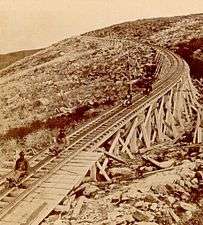 "Devil's shingles" down
"Devil's shingles" down
"Devil's shingle" slideboards
In the early days of the railway's construction, the workers wanted to minimize time when climbing and descending the ramp, so they invented slideboards fitting over the cog rack and providing enough room for themselves and their tools. These boards – no two were exactly alike – were approximately 35 in (90 cm) long by 9.8 in (25 cm) wide, made of wood with hand-forged iron and with two long, hardwood handles usually attached at the down-mountain end. The average time for the descent of the mountain using these boards was about 15 minutes. The record was 2:45, an average speed above 62 mph (100 km/h).[1]
The "Devil's shingles" were banned in 1908 after the accidental death of an employee. However, that didn't stop workers, and there are sources claiming the shingles were used by some up until the 1920s. Later, the design of the rack was changed so that the old braking mechanism could no longer grip.
Accidents
The first of two major accidents in the railway's history occurred in 1929, involving locomotive #1 (first named Hero and later Old Peppersass[6] because of its vertical boiler's resemblance to a pepper sauce bottle). This locomotive was used to build the railway, and operated until retirement in 1878. After a few years on display locally, it was shipped to the World's Columbian Exposition in 1893. The Baltimore and Ohio Railroad (B&O) took possession of the locomotive after the Exposition, and stored it in Baltimore until the 1927 Fair of the Iron Horse celebrating the B&O's 100th birthday. The Boston & Maine Railroad restored Old Peppersass at its Concord shops following the Fair to make a commemorative trip for the railway's 60th anniversary. After ascending to Jacob's Ladder, the locomotive began a planned descent but jumped up and landed to the right of the cog rail when a tooth broke from a gear wheel. The friction brake was unable to prevent the locomotive from accelerating downhill. The crew jumped to safety (though some suffered broken bones), but a photographer riding the engine to take publicity photos fell to his death as the engine plunged off the trestle.[15] The locomotive broke into pieces, but the boiler did not rupture, and the pieces were later reassembled to reconstruct the locomotive for static display. It is now located at the Cog Railway Base Station.[16]
On September 17, 1967, eight passengers were killed and seventy-two injured when Engine #3 derailed at the Skyline switch, about a mile below the summit. The engine rolled off the trestle while the uncoupled passenger car slid several hundred feet into a large rock. An investigation revealed that the Skyline switch had not been properly configured for the descending train. The railway nonetheless has a solid safety record, having taken over five million people to the summit during its existence.[17]
Mechanical design
The cog railway designs and builds all of its locomotives and passenger coaches at the company shops located at the base of Mount Washington.[18]
Each train consists of a locomotive pushing a single passenger car up the mountain, descending the mountain by going in reverse. Both locomotive and car were originally equipped with a ratchet and pawl mechanism engaged during the climb that prevents any roll-back; during descent, both locomotive and car are braked. Recent improvements in design have replaced the ratchet (gear and pawl mechanism) with sprag clutches and disc brake assemblies. Most of the locomotives were made by the Manchester Locomotive Works.[19]
The rack rail design used is one of Marsh's own inventions, using a ladder-like rack with open bar rungs engaged by the teeth of the cog wheel. This system allows snow and debris to fall through the rack, rather than lodging in it.[20] A similar design, called the Riggenbach rack system, was invented by engineer Niklaus Riggenbach in Switzerland at about the same time. The Swiss Consul to the United States visited Marsh while constructing the railway up Mount Washington, and his enthusiastic reports persuaded the Swiss government to commission Riggenbach to build the Vitznau-Rigi-Bahn on Mount Rigi, which opened on May 21, 1871.[21]
Initially, there was no way for two trains to pass one another on the Mount Washington Cog Railway. In 1941, a nine-motion switch was invented, and two spur sidings were added, each long enough to divert two descending trains so that climbing trains could continue to the summit, enabling more round trips per day.

In 2004, work was completed replacing the lower Waumbek Switch and Siding with an 1,800-foot (550 m) passing loop equipped with electric and hydraulically powered automated switches. These switches are powered by batteries and recharged by solar panels. One switch is located at each end of the loop, allowing ascending and descending trains to pass one another.[22]
In 2014, work began on another switch and siding at the summit of Mount Washington. When completed, the new switch will allow trains to pass one another at the summit of the mountain.
In 2008, work began on the first diesel locomotive to be powered with biodiesel, with the assistance of a retired mechanical engineer from the Portsmouth Naval Shipyard.[23] By 2013, the railway had completed the construction of five of these locomotives. Work was completed on a sixth biodiesel in June 2016.
Modern operations
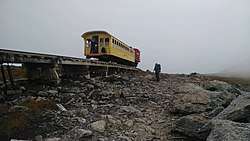
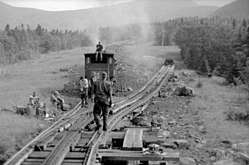
The most common trips on the Cog Railway are between the two main stations, one at the summit and the other adjacent to the operators' logistical and repair base.
From 2003 to 2006, "ski trains" ran, stopping at an intermediate station, from which passengers could ski down to the Base Station.
The Cog Railway track crosses over three hiking trails, including the Gulfside Trail, which is part of the Appalachian Trail. Some hikers have been known to wait for the next train in order to expose their buttocks to the passengers, a practice known as "Mooning the Cog." Several hikers were arrested for performing this act in 2007.[24]
Access to the base station by car is by three routes, each culminating with the upper portion of the dead-end Cog Base Road. The advertised, roughly eastbound route uses the Base Road's full length from Bretton Woods. An especially scenic route, initially southbound from U.S. Route 2, follows Jefferson Notch Road, a narrow dirt road with hairpin turns; it rises 1,500 feet (460 m) to the pass, at 3,000 feet (910 m) above sea level, between Mount Jefferson in the Presidential Range and Mount Dartmouth, before descending to its junction with the Base Road. The Jefferson Notch Road is closed to wheeled vehicles in winter – and usually before and after – and used primarily by snowmobiles. The roughly northbound route from U.S. Route 302 in Crawford Notch via Mt. Clinton Road is also closed in the winter to vehicular traffic. Operations of trains all winter began in 2004–2005, and the Cog Base Road is plowed and sanded all winter to allow tourists, skiers, and employees access to the Base Station.
Environmental concerns
The steam locomotives on the railway generate large amounts of smoke, nicknamed "Cog Smog".[25] The railway is exempted from the state's air-pollution-control law (RSA 125-C:20),[26] which exempts "any steam locomotives and engines or replacements thereof used in connection with the operation of a railroad or railway which were in operation or on order prior to January 1, 1973, and are located entirely within the state."
Each 3 mi (4.8 km) steam locomotive ride burns 1 short ton (0.91 t) of coal and consumes 1,000 US gallons (3,800 l) of water.[27]
One steam locomotive was converted to oil-firing in 2008.[28] The attempt to oil-fire the existing steam locomotives failed, and in 2008 the railway introduced its first diesel locomotive, designed and built by the railroad staff. Since 2008, four more diesels were completed (M-2 and M-3 in 2009, M-4 in 2011, and M-5 in 2013). All the new diesel hydraulic locomotives are operated on B20 (20% biodiesel blend) during the summer season. The company declared that the primary reason the new diesels were built was to reduce the visual pollution caused by the coal-fired steam locomotives, to lower emissions, and to increase the length of time that passengers could spend at the summit of Mount Washington.[19]
Each 3-mile (5 km) diesel locomotive ride burns approximately 18 US gallons (68 l) of B20 (20% biodiesel blend) fuel.
The locomotives push passenger cars that have a capacity of 70 riders. The Cog Railway also rosters eight wooden coaches.
Locomotives
| Number | Name | Image | Builder | Type | Date | Status | Notes |
|---|---|---|---|---|---|---|---|
| 1 | Old Peppersass[6] |  |
Campbell, Whittier and Company | Steam | 1866 | On display | World's first cog locomotive, originally named Hero. Retired in 1878. Reconditioned in 1929 and wrecked 20 July 1929. Reassembled after the wreck and placed on display at Marshfield Station.[15] |
| 1 | Mt. Washington | Manchester Locomotive Works | Steam | 1883 | In storage | Was the first #7 Falcon; renumbered to 1 following rebuilding after the 1895 fire. Renamed Mt. Washington after 1931.[15] Currently stored out of service at the shops. | |
| 2 | Ammonoosuc | 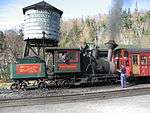 |
Manchester Locomotive Works | Steam | 1875 | Operational | Was second #4 Atlas; renumbered to 2 following rebuilding after the 1895 fire. Named Ammonoosuc after 1931.[15] Equipped with the feedwater heater enhancement. Still operating. |
| 3 | Agiocochook |  |
Manchester Locomotive Works | Steam | 1883 | In storage | Built as #2 of the Green Mountain Cog Railway. Was the third #5, not named; became the third #3 in 1934. Was named the Base Station.[15] This was the locomotive in the fatal accident of 1967. Renamed Agiocochook in 1995 or 1996. Last operated in 2009, and is currently stored serviceable outside the engine shops. |
| 4 | Summit |  |
Manchester Locomotive Works | Steam | 1883 | On display | Built as #1 of the Green Mountain Cog Railway, then became Mount Washington Cog Railway #4 Summit.[15] Renamed Chocorua in 1999/2000. In 2007 it was renumbered and renamed as #8 Moosilauke, coincident with the retirement of the other locomotive with that name and number. Retired after the 2009 season. In July 2013 the locomotive was donated to the village of Twin Mountain and placed on permanent static display at the intersection of U.S. Route 3 and U.S. Route 302. In August 2018, the engine's cab was replaced and retained its original name and number after some refurbishing. |
| 6 | Kancamagus | 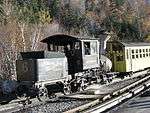 |
Manchester Locomotive Works | Steam | 1874 | In storage | Originally built as first #6 Tip-Top with vertical boiler. Rebuilt into second #6 in 1878 with horizontal boiler. Was named Great Gulf.[15] Renamed Kancamagus in 2000/2001. Last operated in 2010, and is currently stored serviceable inside the engine shops. |
| 8 | Moosilauke |  |
Mount Washington Cog Railway Shop | Steam | 1983 | In storage | Built in 1983 by Mike Kenly at the Cog Shop. At the time was the world's newest steam locomotive. Was named the Tip-Top.[15] Renamed Moosilauke in 2002. Last operated in 2006, and in 2007 a major boiler overhaul was underway when the project was scrapped in favor of building a new diesel locomotive. The cab and tender of #8 Tip-Top/Moosilauke now rides on #4 Summit/Chocorua. The rest of the engine (boiler, firebox, etc.) are currently stored out of service outside the shops. |
| 9 | Waumbek |  |
Manchester Locomotive Works | Steam | 1908 | Operational | First horizontal boiler engine to have the cab on the same plane as the boiler. For a short time, this locomotive burned biodiesel, but was reconverted to coal. Has the feedwater heater enhancement. Still operating. |
| 10 | Col. Teague | 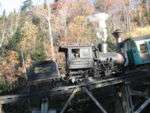 |
Mount Washington Cog Railway Shop | Steam | 1972 | On display | Uses a larger, welded boiler built by Munroe Boiler. Has the cab tilted on the same plane as the boiler. Converted to burn oil for a short time and converted back to coal. Was renamed the KroFlite. Last operated in 2009, and in October 2015 it now sits at the intersection of U.S. Route 302 and Base Station Road, bearing its original name as a sign for the entrance to the railway. |
| M-1 | Wajo Nanatassis |  |
Mount Washington Cog Railway Shop | Diesel | 2008 | Operational | First diesel-hydraulic locomotive. Powered by biodiesel (B20). |
| M-2 | Algonquin |  |
Mount Washington Cog Railway Shop | Diesel | 2009 | Operational | Second diesel-hydraulic locomotive. Powered by biodiesel (B20) |
| M-3 | Abenaki |  |
Mount Washington Cog Railway Shop | Diesel | 2009 | Operational | Third diesel-hydraulic locomotive. Powered by biodiesel (B20) |
| M-4 | Agiocochook |  |
Mount Washington Cog Railway Shop | Diesel | 2010 | Operational | Fourth diesel-hydraulic locomotive. Powered by biodiesel (B20) |
| M-5 | Metallak | 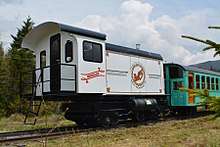 |
Mount Washington Cog Railway Shop | Diesel | 2013 | Operational | Fifth diesel-hydraulic locomotive. Powered by biodiesel (B20) |
| M-6 | LaPrade | Mount Washington Cog Railway Shop | Diesel | 2016 | Operational | Sixth diesel-hydraulic locomotive. Powered by biodiesel (B20) | |
| M-7 | Kenison | Mount Washington Cog Railway Shop | Diesel | 2019 | Operational | Seventh diesel-hydraulic locomotive. Powered by biodiesel (B20) |
See also
References
- "History of the Mount Washington Cog Railway". The Heart of New England. Retrieved September 21, 2008.
- "#220 Pilatusbahn (1882)". American Society of Mechanical Engineers. Archived from the original on December 26, 2010. Retrieved May 13, 2013.
- Coffin, Charles Carleton (May 1885). "Sylvester Marsh 'The Projector of the Mount Washington Railroad'". The Bay State Monthly, A Massachusetts Magazine. 3 (2).
- One or more of the preceding sentences incorporates text from a publication now in the public domain: Wilson, J. G.; Fiske, J., eds. (1900). . Appletons' Cyclopædia of American Biography. 4. New York: D. Appleton. p. 219.
- Johnson, Christopher (2006). This Grand & Magnificent Place: The Wilderness Heritage of the White Mountains. UPNE. p. 54. ISBN 978-1-58465-461-2.
- "The Mount Washington Cog Railway - About The Cog - Mount Washington Cog Railway History". thecog.com. The Mount Washington Cog Railway. 2018. Retrieved March 4, 2018.
Undaunted and driven by his contemporaries’ skepticism, Marsh began the task of building his mountain climbing railway, along with inventors Herrick and Walter Aiken, a father-and-son team from Franklin, New Hampshire...on July 3, 1869, ‘Old Peppersass’ became the first cog-driven train to climb 6,288-foot Mount Washington.
- "Six New England Presidential Visits and the Stories Behind Them". New England Historical Society. Retrieved February 23, 2017.
On Aug. 27, 1869, the Grant family climbed Mount Washington. They took the three-year-old cog railway, the first cog railway in the world.
- "Historical Timeline". Mount Washington Railway Company.
- See also Burt, F. Allen. The Story of Mount Washington. Mt. Washington Cog Railway. Mt. Washington Cog Railway. 1964. and Mt. Washington Cog Railway. Mt. Washington Cog Railway. 1975.
- "A Heritage of Ingenuity: 19th Century meets 21st Century" (PDF). Trip Companion Guide & Map. Mount Washington Cog Railway.
- Teague, Ellen Crawford (1982). I Conquered My Mountain: The Autobiography of Ellen Crawford Teague. Caanan, NH: Phoenix Publishing.
- "Top 10 railroad stories of 2008". Trains News Wire. December 31, 2008. Retrieved January 9, 2009.
- "Cog Railway owners propose hotel". Concord Monitor.
- "Plans for luxury hotel below Mt. Washington summit prompt outcry". The Boston Globe. Retrieved February 2, 2017.
- Johnson, Ronald N. (1979). "Steaming to the Clouds". Rail Classics Magazine: 38–49, 74–75.
- Howe, Nicholas (2000). Not Without Peril. Appalachian Mountain Club. pp. 118–124.
- "Climbing Jacob's Ladder, Scared Stiff". New Hampshire Public Television. Retrieved May 31, 2015.
- Presby, Wayne. "The Mount Washington Cog Railway Goes Green" (PDF). The Mount Washington Cog Railway. Retrieved April 10, 2014.
- While much is made of the ecological significance of the biodiesel-fueled locomotives, as is the case with most biodiesel, the fuel is a blend containing only a small fraction of biodiesel and the rest conventional petroleum-based diesel fuel; 1⁄5 biodiesel in the case of the Mount Washington locomotives.Zimmermann, Karl (May 2011). "A New Moon over New Hampshire" (PDF). Trains. Kalmsbach Publishing Co. Retrieved March 11, 2014.
- Bermudes, Robert W., Jr. (2014). "Mount Washington Railway Company". Cog Railway. WhiteMountainHistory.org. Retrieved March 11, 2014.
- Jehan, David (2003). Rack Railways of Australia (2nd ed.). Illawarra Light Railway Museum Society. ISBN 0-9750452-0-2.
- "Technology". Mount Washington Cog Railway. Retrieved November 23, 2005.
- "From the Shipyard to the Railyard – Al Laprade Important Cog". Website. Mount Washington Cog Railway. 2008. Retrieved April 23, 2014.
- Seacoast Online: "Mooning hikers caught" 15 Nov., 2007
- Kalasky, William (August 31, 2008). "The historic Cog Railway is vanishing". New Hampshire Union Leader. Retrieved September 20, 2010.
- "Chapter 125-C Air Pollution Control". State of New Hampshire. Retrieved April 14, 2008.
- "Cog Railway: Engines". Mount Washington Cog Railway. Archived from the original on October 11, 2007. Retrieved April 14, 2008.
- "Cog Railway gets new biodiesel locomotive". Nashua Telegraph. Associated Press. September 7, 2008. Retrieved September 10, 2008.
External links
| Wikimedia Commons has media related to Mount Washington Cog Railway. |
- www.thecog.com – Mount Washington Cog Railway official site
- Mount Washington Cog Railway history and locomotive roster
- Mount Washington Cog Railway photos
- Mount Washington Railway Company – Historical Timeline
- "Among the Clouds" by John H. Ackerman, American Heritage Magazine, April 1968, Volume 19, Issue 3
- ASME/ASCE 1962 designation of Mount Washington Cog Railway as a National Historic Mechanical and Civil Engineering Landmark